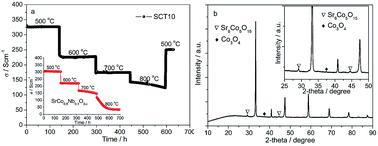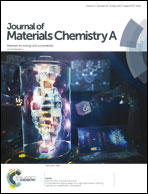Ta-Doped SrCoO3−δ as a promising bifunctional oxygen electrode for reversible solid oxide fuel cells: a focused study on stability
Abstract
The present work reports a thorough investigation into the structural, thermal, electrical and electrochemical properties of 10 mol% Ta-doped SrCoO3−δ (denoted as SCT10) as a promising bifunctional oxygen electrode for intermediate-temperature reversible solid oxide fuel cells. The high-temperature X-ray diffraction (HT-XRD) and high-temperature neutron powder diffraction (HT-NPD) studies reveal that SCT10 exhibits a single primitive cubic phase at ≥200 °C. The thermogravimetric analysis (TGA) and HT-NPD show consistent results of oxygen nonstoichiometry and the oxidation-state of Co-ions as a function of temperature. More importantly, the dependency of electronic conductivity and electrochemical activity on temperature, partial pressure of oxygen and time unequivocally suggests that SCT10 is a better and more stable bifunctional oxygen electrode than its rival, 10 mol% Nb-doped SCO (SCN10), making it more attractive for practical applications.



 Please wait while we load your content...
Please wait while we load your content...